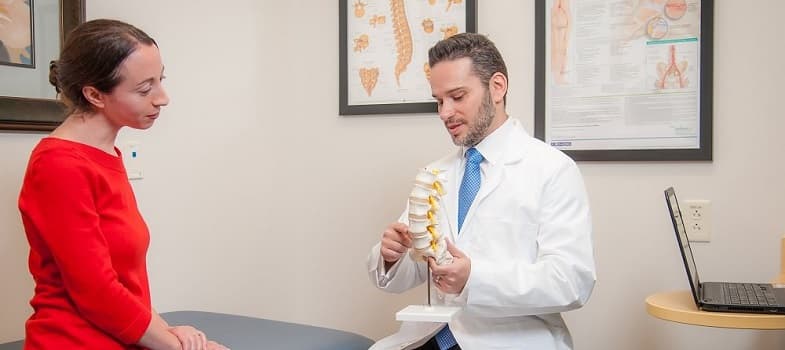What is Post-laminectomy Syndrome?
In the United States, approximately 500,000 spinal surgeries are performed annually. Unfortunately, some 20% of patients report ongoing back pain following spinal surgery. Lack of pain relief after spinal surgery is called post-laminectomy syndrome, or failed back syndrome.
Patients with post-laminectomy syndrome often live with chronic pain and disability, which can cause significant distress.Their suffering may be exacerbated by financial pressure arising from inability to sustain employment. Clearly, post-laminectomy syndrome is a challenging and costly disorder.
Fortunately, there are pain relief options available for individuals who suffer from back pain following surgery. The practitioners at Wake Spine & Pain Specialists bring years of pain management expertise to their patients, and truly understand the inconvenience of living with a painful condition. What’s more, they are committed to providing patients with the most modern and minimally invasive treatment approaches available.
Causes of Post-laminectomy Syndrome
Recurring pain after spinal surgery may arise from a variety of causes. Frequent causes include returning disc herniation and nerve root compression. Other causes include: scar tissue build-up (fibrosis), joint hypermobility, spinal instability, and facet joint problems. Sometimes returning pain after back surgery arises from systemic reasons such as diabetes, autoimmune disorders and peripheral vascular disease. Post-surgical back pain may also be caused by depression, anxiety, sleep problems, smoking and the release of inflammatory mediators.
Inflammatory mediators are thought to contribute to chemical inflammation of nerve roots (Peng et al, 2007; Sommer et al, 2004; Takashi et al, 1996). One such mediator is tumor necrosis factor-alpha (TNF-a), a chemical released by herniated or torn discs, degenerating facet joints, and in spinal stenosis (Igarashi et al, 2004; Sakuma et al, 2007). The release of TNF-a may cause pain and inflammation, and promote further disc degeneration (Séguin et al, 2005). If the cause of a patient’s back pain is chemical in nature, then surgery might not relieve the pain, and might even exacerbate it, resulting in post laminectomy syndrome.
The pain experts at Wake Spine & Pain Specialists are dedicated to accurate diagnosis of the underlying causes of your post-surgical back pain. Once the cause of pain has been pinpointed, an effective, minimally invasive, personalized pain management strategy can be devised to help manage the painful condition.
Smoking
There is an association between cigarette smoking, back pain, and chronic pain syndromes of all types (Boshuizen et al, 1993; Heliovaara et al, 1991). For example, a study that examined associations between back pain prevalence and lifestyle factors (smoking and obesity) using national survey data found back pain prevalence rose with increasing levels of smoking, with a relative risk of 1.47 for persons reporting 50 or more pack-years of smoking (Deyo et al, 1989). Further, recent studies have shown that cigarette smokers are less likely to experience eradication of pain after spinal surgery. One reason for this is that nicotine appears to interfere with bone metabolism. Smoking may also lead to increased scar tissue buildup by constricting the diameter of blood vessels (Hollo et al, 1977; Iwahashi et al, 2002).
Since smoking may lower the likelihood of successful outcomes, some surgeons consider it an absolute contraindication to back surgery. Fortunately, there are many new smoking cessation therapies available. These include nicotine replacement therapies, which are delivered as gums, lozenges, sprays, inhalers, and patches; specific antidepressants such as Bupropion; Nicotinic receptor partial agonists such as cytisine and varenicline; medications that reduce withdrawal symptoms; electronic cigarettes; hypnotherapy; and cognitive behavioral therapy.
Post-laminectomy Syndrome Symptoms
Typically, the nature of the pain experienced by patients with post-laminectomy syndrome correlates with the underlying pathology. One type of post laminectomy pain is neuropathic pain, which is caused initially by primary injury to the nervous system. In patients with post-laminectomy syndrome, the original spinal disorder that caused the nerve injury prior to surgery may cause neuropathic pain to return. Another type of pain that may persist after back surgery is radicular pain, or shooting pain that travels along the dermatome or sensory distribution of a nerve due to inflammation or other irritation of the nerve root. Initially, nerve root irritation may arise from a spinal disc herniation, or torn or bulging disc. Eventually, neuropathic and radicular pain can result in central sensitization of nervous tissues, or harmful changes to pain receptors.
In central sensitization, chronic injury and inflammation in peripheral tissues eventually prompt pain receptors in the central nervous system to overreact to normal physical sensations. Low-threshold sensory fibers activated by light touch of the skin trigger neurons in the spinal cord that normally respond only to painful stimuli. As a result, harmless stimuli eventually provoke feelings of pain, a phenomenon known as allodynia. An increased response to a painful stimulus, or hyperalgesia, may also occur.

Diagnosis of Post-laminectomy Syndrome
As with any painful condition, the most effective treatment is based upon accurate diagnosis of the underlying problem. State-of-the-art diagnostic techniques are used to help pinpoint the cause of pain. The doctor will take a medical history and perform an examination, and may order various tests such as x-rays, MRI, electromyography (EMG) and nerve conduction studies, or x-ray guided diagnostic spinal injections. Upon discovering the exact cause of pain, the pain expert will work with you to develop an effective treatment plan.
Treatment of Post-laminectomy Syndrome
Wake Spine & Pain Specialist physicians will help patients gain dramatic, long-lasting relief from recurring back pain, and regain a better quality of life. Your treatment regimen may include a specific array of conservative measures and innovative procedures.
Some of the basic interventions used to treat post-laminectomy syndrome include physical therapy and specialized exercises. According to a report in the New England Journal of Medicine, these “ancillary approaches may all be useful adjuncts to anti-inflammatory approaches” (Carragee, 2005). Another basic means of controlling post-surgical back pain is anti-inflammatory medication, such as non-steroidal anti-inflammatory drugs (NSAIDs).
Another type of medication sometimes prescribed to patients with persistent back pain includes specialized inhibitors designed to combat the chemical mediator TNF-a, which has been implicated as a cause of inflammatory spinal pain (Uçeyler et al, 2008). In the 1990s, these medications became available in the United States. One of these TNF-a inhibitors, etanercept, has been shown in studies to be effective for treating patients with post laminectomy syndrome who have inflammation-related pain (Sommer et al, 2001; Olmarker et al, 2001).
Another treatment modality for post-laminectomy syndrome is the use of neuromodulation techniques such as spinal cord stimulation (SCS). A review states neuromodulation techniques often resolve chronic pain following spinal surgery without having to resort to repeat surgery and/or spinal fusion (Robaina-Padrón, 2008). In fact, rates of success, defined as a relative decrease in pain, for implanted neurostimulation devices have been reported to be 25% to 55% (De la Porte et al, 1983). A randomized, controlled trial found SCS is more effective than reoperation as a treatment for persistent radicular pain after spinal surgery, and in the great majority of patients, it obviates the need for reoperation (North et al, 2005). Another trial found SCS effectively helped control pain in 62 of 116 patients with pain in the back and lower extremities (of these, 56 exhibited post laminectomy syndrome) over follow-up periods ranging from 6 months to 10 years, with a mean follow-up period of 40 months (Kumar et al, 1991). Of these patients, 48 individuals (40%) were able to control their pain by neurostimulation alone, and a further 14 patients (12%), in addition to following a regular stimulation program, needed occasional analgesic supplements to achieve 50% or more relief of the pre-stimulation pain. And another clinical trial found 50% or better pain relief lasted in 76% of 32 post laminectomy syndrome patients who received SCS and still had stimulators present at 1 year, and 74% of the 19 patients with stimulators still present at 2 years (LeDoux & Langford, 1993).

In addition, epidural steroid injections (ESIs), or injections of local anesthetic and steroids may be used in patients who fail to achieve pain relief after back surgery. According to three reviews, there is moderate evidence to suggest ESIs are efficacious in managing lumbar radicular pain in post lumbar laminectomy syndrome (Abdi et al, 2007; Conn et al, 2009; Boswell et al, 2007). In general, the efficacy of ESIs for managing back pain is backed by various clinical studies. One such study, a prospective, double-blind, randomized, case-control study in patients suffering from severe chronic low back pain and sciatica, concluded ESIs seem to be effective in treating these patients based upon the results of post-procedural tests measuring pain and functionality (Sayegh et al, 2009).
And another minimally invasive, efficacious treatment modality for patients with post laminectomy syndrome may be radiofrequency ablation (RFA). A study showing the overall success of RFA in treating back pain found 26 (53.06%) of 49 patients and 59 (50.86%) of 116 patients after cervical and lumbar pulsed-RFA, respectively, had an initial improvement of 50% or more in the first week of follow-up (Chau et al, 2008). Further, 27 (55.10%) of 49 patients and 52 (44.83%) of 116 patients after cervical and lumbar pulsed-RFA, respectively, had pain relief of 50% or more at the follow-up period of 3 months.
At Wake Spine & Pain Specialists, our caring practitioners understand the stress and inconvenience of living with a painful condition and aim to bring patients back to health as quickly, efficiently and non-invasively as possible. With our numerous combined years of experience, we are confident we can design the optimal pain management plan to address your individual needs.
References
- Abdi S, Datta S, Trescot A, Schultz D, Adlaka R, Atluri SL, Smith H, Manchikanti L. (2007). Epidural steroids in the management of chronic spinal pain: a systematic review. Pain Physician. 10(1):185-212.
- Boshuizen H. et al. (1993). Do smokers get more back pain? Spine 18 (1): 35–40.
- Boswell MV et al. (2007). Interventional techniques: evidence-based practice guidelines in the management of chronic spinal pain. Pain Physician. 10(1):7-111.
- Carragee E. (2005) Clinical practice. Persistent low back pain. N Engl J Med. 352(18):1891-8.
- Chao S et al. (2008) Percutaneous pulsed radiofrequency in the treatment of cervical and lumbar radicular pain. Surg Neurol. 70(1):59-65.
- Conn A, Buenaventura R, Datta S, Abdi S, Diwan S. (2009). Systematic review of caudal epidural injections in the management of chronic low back pain. Pain Physician. 12(1):109-35.
- De la Porte C, Siegfried J (1983). Lumbosacral spinal fibrosis (spinal arachnoiditis). Its diagnosis and treatment by spinal cord stimulation. Spine 8 (6): 593–60
- Deyo R. A. et al. (1989). Lifestyle and low-back pain. The influence of smoking and obesity.. Spine 14 (5): 501–506.
Heliovaara M. et al. (1991). Determinants of sciatica and low-back pain.. Spine 16 (6): 608–14. - Hollo I, Gergely I, Boross M. (1977). Smoking results in calcitonin resistance. JAMA 237 (23): 2470
- Igarashi A, Kikuchi S, Konno S, Olmarker K (2004). Inflammatory cytokines released from the facet joint tissue in degenerative lumbar spinal disorders. Spine 29 (19): 2091–5.
- Iwahashi M. et al. (2002). Mechanism of intervertebral disc degeneration caused by nicotine in rabbits to explicate intervertebral disc disorders caused by smoking. Spine 27 (13): 1396–1401.
- Kumar K, Nath R, Wyant GM. (1991) Treatment of chronic pain by epidural spinal cord stimulation: a 10-year experience. J Neurosurg. 75(3):402-7.
- LeDoux M, Langford K. (1993). Spinal cord stimulation for the failed back syndrome. Spine (Phila Pa 1976). 1993 Feb;18(2):191-4.
- North R, Kidd D, Farrokhi F, Piantadosi S. (2005). Spinal cord stimulation versus repeated lumbosacral spine surgery for chronic pain: a randomized, controlled trial. Neurosurgery. 56(1):98-106; discussion 106-7.
- Peng B, Wu W, Li Z, Guo J, Wang X. (2007). Chemical radiculitis. Pain. 127(1-2): 11–6.
- Robaina-Padrón FJ. (2008). [Lumbar post laminectomy syndrome: II. Pain management using neuro-modulation techniques]. [Article in Spanish] Neurocirugia (Astur). 19(1):35-44.
- Sakuma Y, Ohtori S, Miyagi M, et al. (2007). Up-regulation of p55 TNF alpha-receptor in dorsal root ganglia neurons following lumbar facet joint injury in rats. Eur Spine J 16 (8): 1273–8.
- Sayegh F, Kenanidis E, Papavasiliou K, Potoupnis M, Kirkos J, Kapetanos G. (2009). Efficacy of steroid and nonsteroid caudal epidural injections for low back pain and sciatica: a prospective, randomized, double-blind clinical trial. Spine (Phila Pa 1976). 34(14):1441-7.
- Séguin C, Pilliar R, Roughley P, Kandel R. (2005). Tumor necrosis factor-alpha modulates matrix production and catabolism in nucleus pulposus tissue. Spine 30 (17): 1940–8.
- Sommer C, Schafers M (2004). Mechanisms of neuropathic pain: the role of cytokines. Drug Discovery Today: Disease Mechanisms 1 (4): 441–8.
- Takahashi H, Suguro T, Okazima Y, Motegi M, Okada Y, Kakiuchi T (1996). Inflammatory cytokines in the herniated disc of the lumbar spine. Spine 21 (2): 218–24
- Uçeyler N, Sommer C. (2008). [Cytokine regulation and pain. Results of experimental and clinical research]. [Article in German]. Schmerz. 22(6):652-64.


